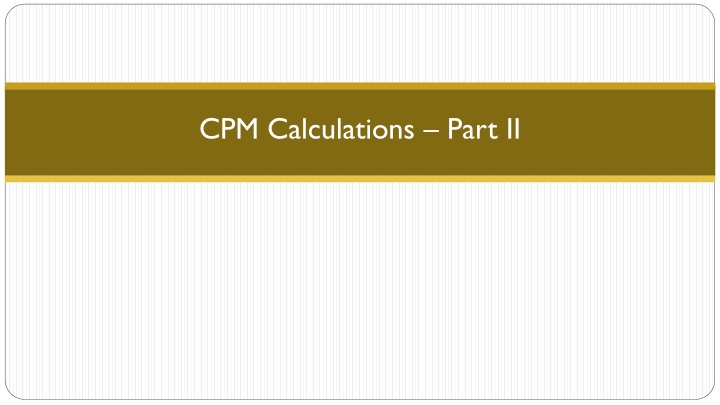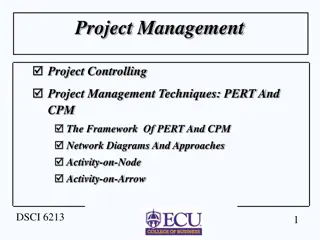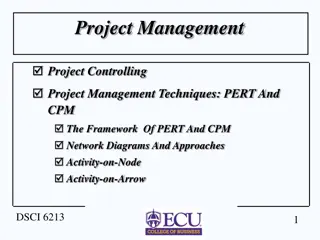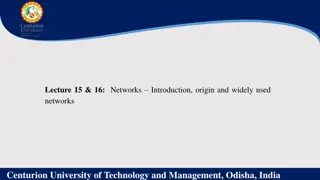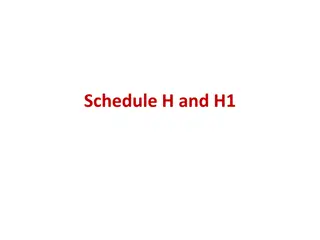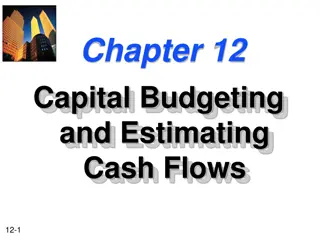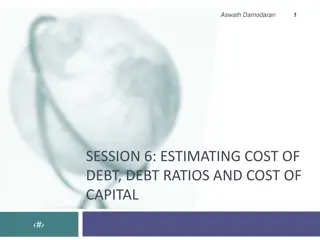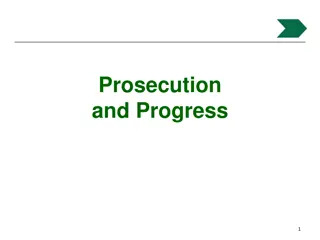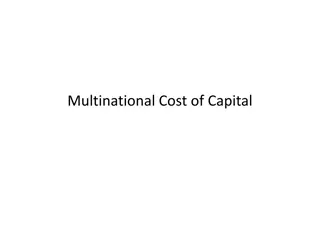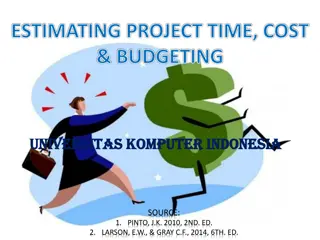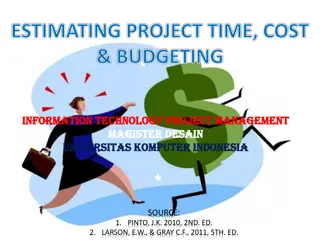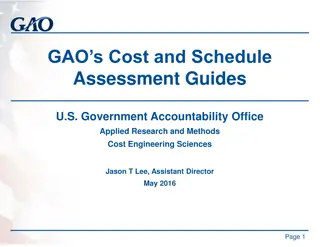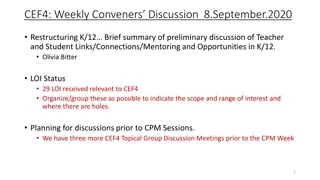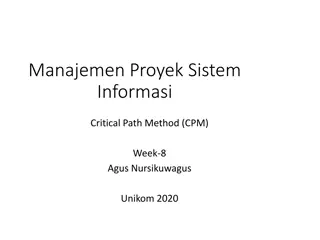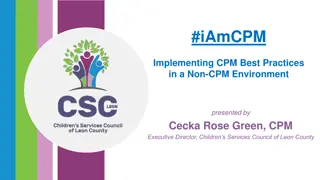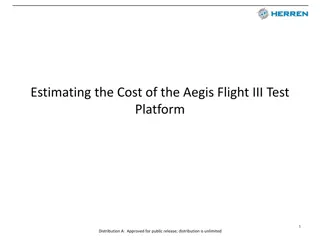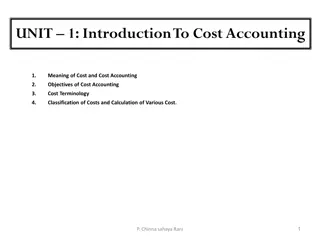CPM Schedule and Cost Estimating
In this module, you will learn about Critical Path Method (CPM) calculations, determining activity durations, developing CPM logic diagrams, and estimating costs. The content covers steps involved in a CPM schedule, methods for estimating activity durations, and the importance of accurate cost estimation for project management.
Download Presentation

Please find below an Image/Link to download the presentation.
The content on the website is provided AS IS for your information and personal use only. It may not be sold, licensed, or shared on other websites without obtaining consent from the author.If you encounter any issues during the download, it is possible that the publisher has removed the file from their server.
You are allowed to download the files provided on this website for personal or commercial use, subject to the condition that they are used lawfully. All files are the property of their respective owners.
The content on the website is provided AS IS for your information and personal use only. It may not be sold, licensed, or shared on other websites without obtaining consent from the author.
E N D
Presentation Transcript
Module Learning Objectives Determine activity duration Describe and develop CPM logic diagram Calculate forward pass for CPM Calculate backward pass for CPM
The CPM Schedule In our last module we have learned that a CPM schedule involves five steps. They are: Determine the work activities: Any project, no matter how large or small, must be divided into smaller entities, called activities, or tasks Determine activities resources: labor (human), materials, and equipment Determine activities durations: time estimates for each operation Determine logical relationships: Determine FS, SS, FF, & SF and draw logic diagram Perform the CPM calculations: ES, EF, LS, LF, TF, FF
COST ESTIMATING An estimate is at best a close approximation of the actual cost A project cost estimate is unique to that project Even when compared to other, similar projects Soundness of the completed estimate depends on: Accuracy of the quantity take-off and Judicious selection of unit costs and production rates
Estimating Durations The method used to establish duration of an activity depends on the size of the activity and the amount of accuracy required Most opt to analyze the operation in detail Schedulers with significant relevant experience may be able to make a good guess A scheduler can consider performances on past projects, and thus make the duration estimates Without actually performing any detailed analysis Durations are generally recorded in terms of whole days See example on Page 50 of the handout Determining Activity Durations
Methods of Duration Estimates Expert Judgment Analogous Estimating Parametric Estimating Three-Point Estimating Bottom-up Estimating Group Decision-Making Techniques
Estimating Durations Example Determine the number of sheathing panels required to cover the 8 -0 high walls of a building measuring 24 -6 13 -0 . A door opening measuring 3 -0 6 -8 and two window openings measuring 2 -6 3 -0 each are placed in the walls. Each sheathing panel covers 25 sft. Consider a waste factor of 7%. If a crew can install 5 sheathing panel per hour, how long will it take to install the sheathing panels?
Practice Example Suppose, your project needs four .NET developers, two User Experience professionals, and one Project Manager. The rates for each of these team members are: .NET Developers: $80/hour User Experience Professionals: $90/hour Project Manager: $100/hour The .NET developers divide the project into 40 units. If the productivity of the four .NET developers is 0.4 unit/hr, how long will it take them to finish the project? If The project requires the User Experience professionals for 50 hours, and the Project Manager for 100 hours, how much the project will cost?
For Your Project Activity Name Quantity Resources and Productivity Duration Calculation Footer 18 x9 , reinforced 100 CY C-14C, 35 CY/day Duration = 100CY/(35 CY/day) = 2.85 days 3 days
Activity Relationships Relationship is the determination of the sequence, or linking of activities. Activities may be independent. Activities may be dependent. Logic involves the determination of the constraints on activities. For example, you cannot place the concrete until the formwork and reinforcement are erected. You cannot hang the drywall until framing is done.
Links Dependencies between activities are indicated by dependency or sequence lines going from one activity to another. B A C
Activity Relationships Finish to Start (FS) Task B cannot begin until the task A is complete A B For example, "Pour concrete" task cannot begin until the "Dig foundation" task is complete
Activity Relationships Start to Start (SS) Task B cannot start until task A starts A B Example - Excavation for the foundation cannot start until clearing and grubbing begins
Activity Relationships Finish to Finish (FF) Task B cannot finish until task A finishes A B Example - "Inspect electrical" can't finish until "Add wiring" finishes
Activity Relationships Start to Finish (SF) Task B cannot be completed until the task A begins A B For example, the roof trusses for your construction project are built offsite. Two of the tasks in your project are "Truss delivery" and "Assemble roof." The "Assemble roof" task cannot be completed until the "Truss delivery" task begins.
CPM Logic Diagram A graphical representation of the project. Shows all activities and their dependencies. Each activity in the network must be preceded either by the start of the project or by the completion of a previous activity.
CPM Logic Diagram Each path through the network must be continuous, with no gaps, discontinuities, or dangling activities. The diagram should start with a single opening or starting activity and conclude with a single closing or finishing activity.
CPM Logic Diagram Make sure the Logic is correct Two critical questions to ask yourself of each activity. Go through the complete logic diagram asking these two questions to each and every activity. These questions will put your mind in another gear and help to make sure the logic is correct. Does this activity really have to be done before each of the following activities can start? What other activities need to be done before this activity can start? It is critical that the logic is accurate as to the predecessors and successors of each activity in the project. If the logic diagram is not accurate the results will be a bogus schedule that will be frustrating to everyone involved.
CPM Calculating Start and Finish Dates Once the network logic diagram has been created and the durations have been added to the activities, the calculations can be done to determine the start and finish dates While, in practice, most calculations are now performed by scheduling software programs, it is still important for the scheduler to have a thorough understanding of the specific nature of the computations that are performed in determining the schedule information
CPM Calculating Start and Finish Dates Early Start: the earliest time an activity can possibly start, allowing time for the completion of predecessor activities. Early Finish: earliest time by which an activity can be finished and is determined by adding the activity s duration to its early start time. Late Start: the latest time an activity can start if the project completion date is to be met and is determined by subtracting the activity s duration from its late finish time Late Finish: the latest an activity can finish and allow the project to be completed by a specified date. Activity times are usually expressed in terms of expired working days. Therefore, the start of the project is customarily taken to be at zero time.
CPM Calculating Start and Finish Dates The Story Early Finish Early Finish Early Start Early Start 8 am 10 am 8 am 11 am Buy Food Gather Hunting Gear 10 am Late Start 12 pm 9 am Late Start 12 pm Late Finish Late Finish Early Finish Early Start 8 am 12 pm Fix Car 8 am Late Start 12 pm Late Finish
CPM Calculating Start and Finish Dates Early Start: the earliest time an activity can possibly start, allowing time for the completion of predecessor activities. Early Finish: earliest time by which an activity can be finished and is determined by adding the activity s duration to its early start time. Late Start: the latest time an activity can start if the project completion date is to be met and is determined by subtracting the activity s duration from its late finish time Late Finish: the latest an activity can finish and allow the project to be completed by a specified date. Activity times are usually expressed in terms of expired working days. Therefore, the start of the project is customarily taken to be at zero time.
CPM Calculating Start and Finish Dates Each activity is depicted in the following manner Activity Duration Early Start Early Finish Activity Description Late Start Total Float Late Finish
CPM Calculating Start and Finish Dates Example: Warehouse Logic Diagram (From handout Calculating Start and Finish Dates )
Activity ID Activity Duration (Day) IPA CPM Calculating Start and Finish Dates 20 Form & Pour Slab 10 Excavate 3 - 6 10 Example: Warehouse 40 Frame Ext Walls 30 Temp Power 1 10 5 20,30 50 Frame Roof 2 40 60 Install Windows & Doors 3 40 70 Rough Electrical 4 50 80 Shingle Roof 2 50 90 Brick Front Side 5 60 100 Install Siding 4 60 110 Insulate 3 60,70 120 Paint Exterior 3 100 130 Install Drywall 6 80,110 140 Paint Interior 3 130 150 Finish Electrical 2 90,120,140 160 Close Out 1 150
CPM Calculating Start and Finish Dates The Forward Pass: With the network logic diagram completed and the activity durations included for the warehouse project, the next step is to calculate the early start and early finish dates. This process is typically referred to as the forward pass. The calculations start at the beginning of the project and move to the end of the project, or from left to right Pick activity or activates that start the project. In the example, activity Excavate initiate the project. To begin the calculations, put a zero (which represents the morning of the first day) in the early start (ES) area of the activity box. Add the duration to the ES and that results in the early finish (EF) day for the first activity EF = ES + Duration = 0 + 3 = 3 ES Dur EF 0 3 3 Excavate
CPM Calculating Start and Finish Dates The Forward Pass: The second activity can start as soon as the first activity has finished; therefore, the next step is to transfer, or copy, the EF of the predecessor activity to the ES of the successor activity. 3 + 6 = 9 3 6 9 Form & Pour Slab 0 3 3 Excavate 3 1 4 Temp. Power
CPM Calculating Start and Finish Dates The Forward Pass: If there are two or more activities (arrows) as predecessors to a single activity, choose the one with the largest EF day to insert into the successor activity. This is done because both activities need to be finished before the successor activity can start. Notice in the Figure the ES for Frame Ext. Walls is the largest EF of the predecessor activities, the 9, not the 4. Then, add the duration to get the EF day: 9 + 5 = 14. Hence, the EF for Frame Ext. Walls is the end of day 14. 3 6 9 9 + 5 = 14 Form & Pour Slab 9 5 14 Frame Ext. Wall 3 1 4 Temp. Power Largest of ( EF of Form & Pour Slab and EF of Temp. Power) = largest (9, 4) = 9
CPM Calculating Start and Finish Dates The Forward Pass: Continue in a like manner, always choosing the larger of the predecessors for the ES day, adding the duration to get the EF day and continuing this through the rest of the network as shown in Figure. As can be seen from the network in Figure, the project is scheduled to finish on the end of day 35
CPM Calculating Start and Finish Dates The Backward Pass: With the forward pass completed, the early start and finish days have been established. To establish the late start and finish days, the same concept is followed, except that everything is done backward. Therefore, it is called the backward pass. The calculations begin at the end of the project and move to the beginning of the project, or from right to left. If two arrows back into an activity, the lowest number is chosen
CPM Calculating Start and Finish Dates The Backward Pass: To begin the backward pass calculations, go to the last activity and copy the EF day (top right cell) into the LF (bottom right) cell of the activity box as shown in Figure. This is the standard or default method of starting the backward pass because it is typical to want the late finish day to be the same day as the early finish day. Then, subtract the duration from the LF day and that gives the LS day for that last activity as shown in Figure. 34 1 35 Close Out LS = LF Duration = 35 1 = 34 34 35
CPM Calculating Start and Finish Dates The Backward Pass: Next, move to the predecessor of the last activity and copy the LS day of the successor to the LF of the predecessor as shown in Figure. Close Out has an LS day of 34, so this becomes the LF day for Finish Electrical. Then, subtract the Finish Electrical duration of 2 days (34 2 = 32) and this calculates the LS for Finish Electrical to be day 32 34 1 35 32 Finish Electrical 32 2 34 Close Out 34 35 34 LS = LF Duration = 34 2 = 32
CPM Calculating Start and Finish Dates The Backward Pass: During the backward pass, when there are two successor activities (noted by arrows) backing into a single activity, choose the one with the earliest LS day to become the LF day to insert into the predecessor activity as shown in Figure. For example, both Frame Roof (LS of 14) and Windows & Doors (LS of 17) are backing into Frame Ext. Walls. So, the number to enter into the LF of Frame Ext. Walls (lower right) is 14, the earliest or smallest. Remember to focus on the bottom numbers in the activity box. Then subtract the duration of 5 days to get the LS day for Frame Ext. Walls. (14 5 = 9). 14 2 16 9 5 14 Frame Roof Frame Ext. Walls 14 16 9 14 14 3 17 Smallest of ( LS of Frame Roof and LS of Windows and Doors) = smallest (14, 17) = 14 Windows and Doors 17 20
CPM Calculating Start and Finish Dates The Backward Pass: Continue in this manner, always choosing the smaller number backing into the activity, then subtracting the duration, to get the LS day When the backward pass is complete, the ES and the LS of the first activity should both be zero
CPM Example 2 Draw the logic diagram and then check it in the next slide Activity A B C D E F G H I Duration 6 5 3 1 4 10 12 8 5 IPA - A A, D A B C, E, G D E, F, G G
CPM Example 2 This is the logic diagram. Do the forward pass then check it in the next slide 4 5 E B 6 3 10 A 8 C F H PF 1 D 12 5 G I
CPM Example 2 This is the logic diagram. Do the forward pass then check it in the next slide 11 4 15 6 5 11 E B 0 6 6 7 3 10 37 19 10 29 A 29 8 37 C F H PF 6 1 7 D 7 12 19 19 5 24 G I
CPM Example 2 This is the logic diagram. Do the forward pass then check it in the next slide 11 4 15 6 5 11 E B 15 19 10 15 0 6 6 7 3 10 37 19 10 29 A 29 8 37 C F 0 6 H 16 19 PF 19 29 29 37 6 1 7 D 7 12 19 37 6 7 19 5 24 G I 7 19 32 37
